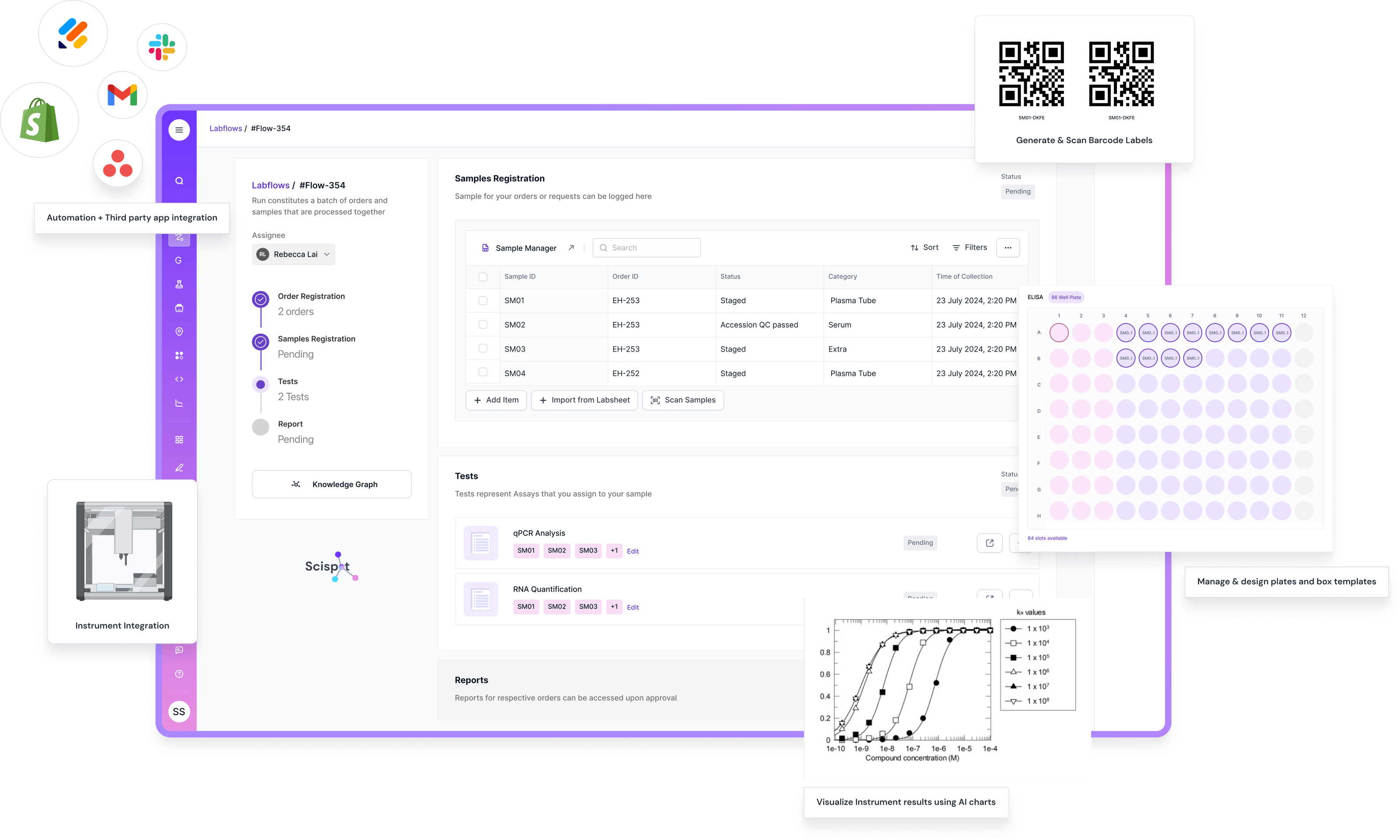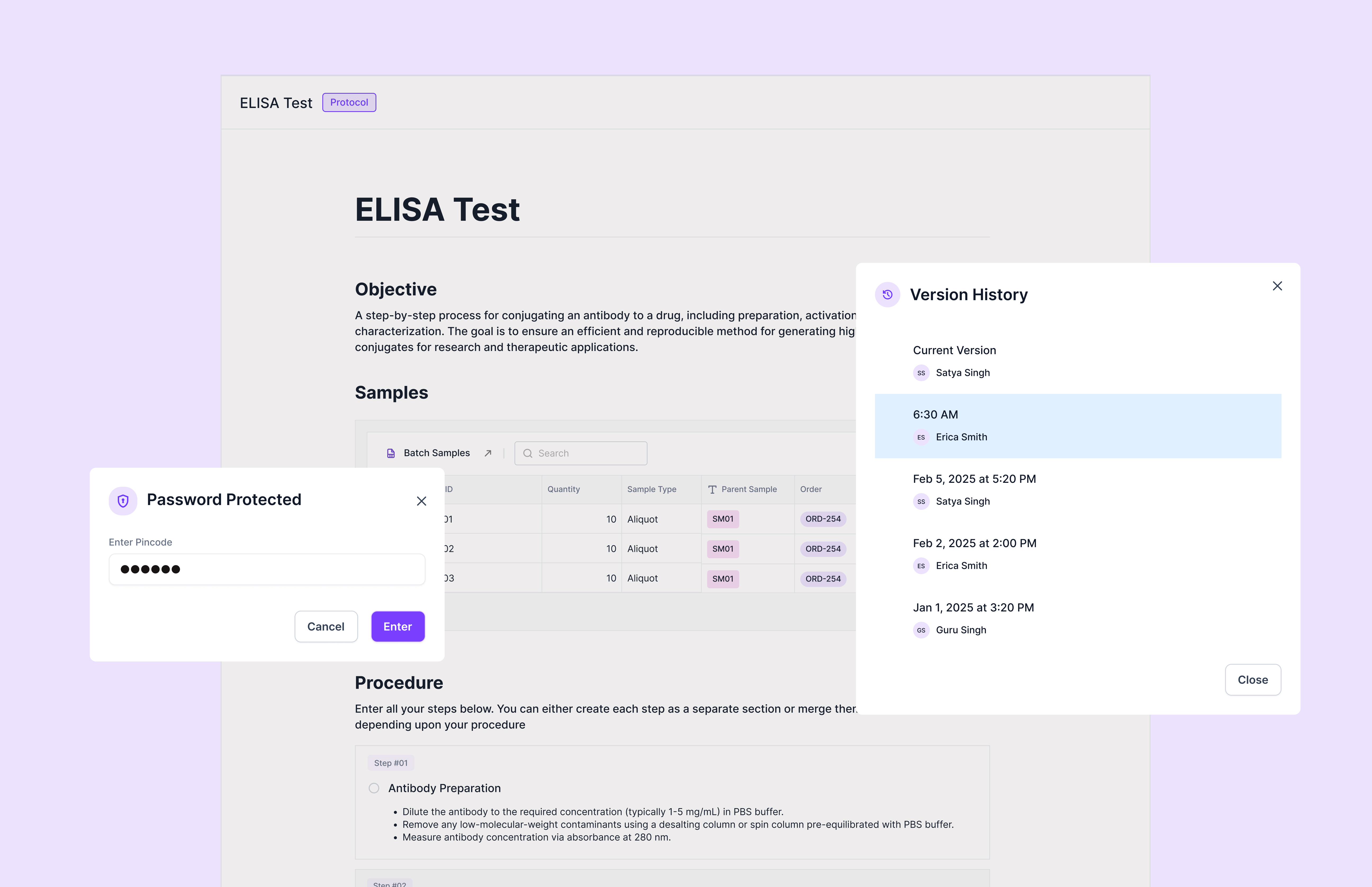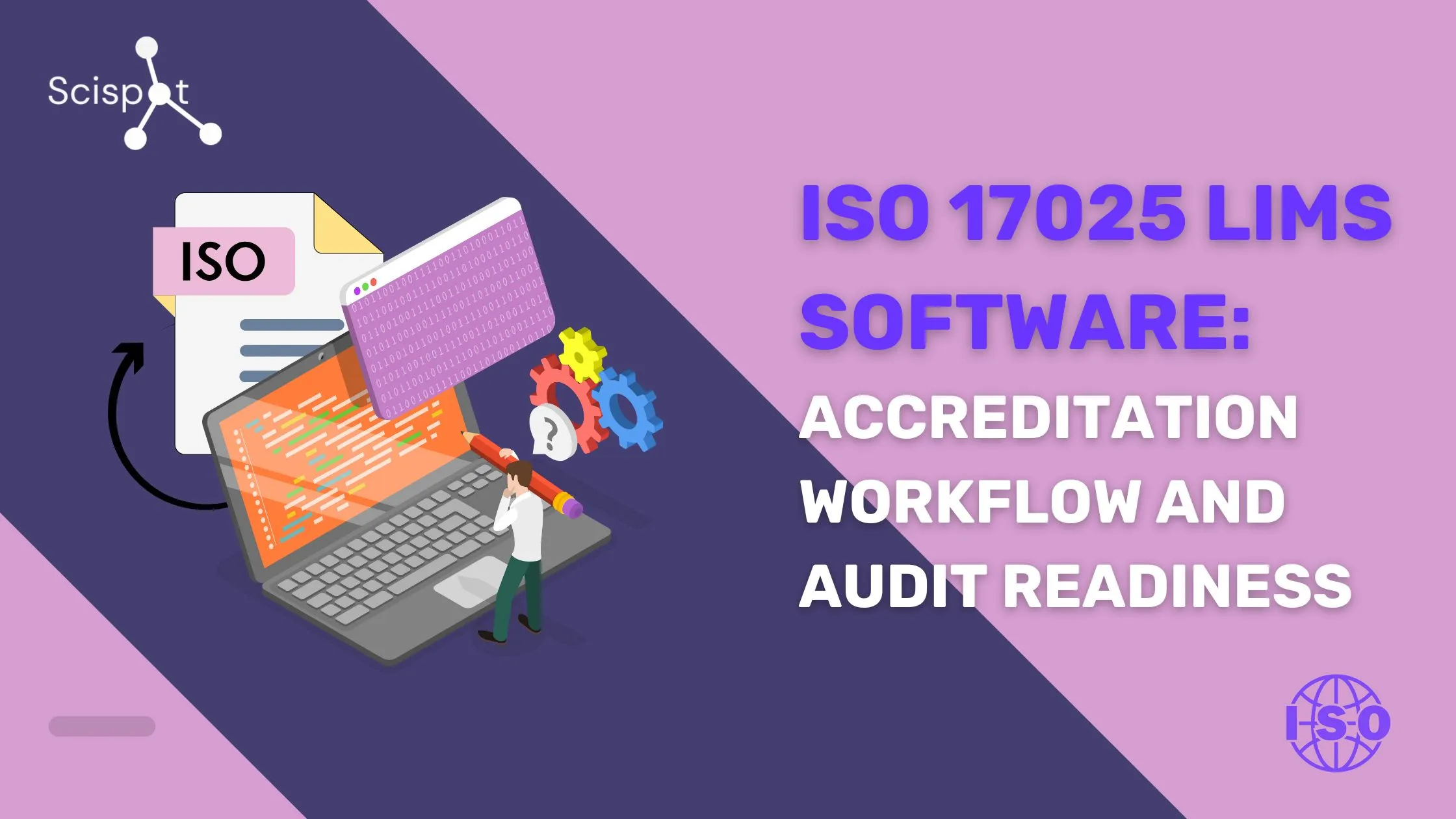ISO/IEC 17025 is the global benchmark for testing and calibration laboratories. It validates that a lab operates competently, impartially, and consistently produces valid results. Implementing an ISO 17025 LIMS software ensures that every part of your laboratory — from sample management to document control — aligns with the accreditation requirements. While the standard defines “what” must be done, a LIMS (Laboratory Information Management System) defines “how” to do it efficiently.
Scispot’s ISO 17025-compliant LIMS transforms the accreditation journey into an automated, traceable process. It integrates LIMS, ELN (Electronic Laboratory Notebook), and QMS (Quality Management System) under one umbrella. This unified ecosystem eliminates silos, standardizes workflows, and ensures audit readiness — not just once a year, but every single day.

The Scope of ISO 17025 for Modern Labs
ISO/IEC 17025:2017 applies to any organization performing testing or calibration. The scope extends to ensuring impartiality, technical competence, traceability, and consistent operations. It defines five key areas: general, structural, resource, process, and management system requirements.
A LIMS for ISO 17025 centralizes all these components. It helps labs document every step — from the sample intake to final reporting — within a controlled and traceable framework. Scispot’s audit-ready design provides clause-level coverage for ISO 17025, ensuring that every process, instrument, and operator action has a verifiable digital footprint. When an assessor asks for evidence, Scispot delivers it in seconds, not hours.
Document Control, SOPs, and Competency Tracking
ISO 17025 requires strict document control, up-to-date Standard Operating Procedures (SOPs), and competency verification for all staff. Scispot’s ISO 17025 document control software keeps all versions of SOPs, training manuals, and quality procedures in one place, automatically tracking approvals and “read & understand” acknowledgments.
Every SOP in Scispot is interactive. Instead of static PDFs, they become executable workflows directly connected to the ELN and LIMS modules. Competency management links personnel qualifications to specific instruments and methods, making it easy to demonstrate to auditors who is authorized to perform each test. When a method or SOP changes, Scispot automatically reissues related training tasks and updates competency records.

Equipment Calibration and Measurement Uncertainty Management
Clauses 6.4 and 6.5 of ISO 17025 focus on equipment control and metrological traceability. Scispot’s LIMS calibration module maintains comprehensive records for every instrument, including calibration schedules, certificates, maintenance history, and service-provider traceability.
Measurement Uncertainty (MU) is another critical pillar. Scispot lets you store and calculate uncertainty budgets for each analytical method. These records are linked directly to test results, ensuring transparency. Dashboards provide trends of calibration performance over time, helping labs predict potential issues before they impact results. With Scispot, uncertainty evaluation moves from spreadsheets into a digital, validated environment that aligns perfectly with ISO 17025 clauses.
Corrective Actions, Nonconformances, and CAPA Workflows
Nonconforming work and corrective actions form the backbone of continuous improvement under ISO 17025. In Scispot, when a deviation or failure occurs, it automatically creates a Nonconformance (NC) record. The issue is linked to impacted samples, instruments, and personnel.
The integrated CAPA (Corrective and Preventive Action) system guides users through structured root cause analysis, risk evaluation, and action planning. Whether you use the Five Whys or fishbone methodology, Scispot captures every step — from detection to resolution and verification. Once actions are implemented, effectiveness checks are logged, ensuring closure before audits. This approach turns ISO 17025 compliance into a living process rather than a reactive task.

Internal Audit and Management Review
Internal audits are the dress rehearsals for accreditation. Clause 8.8 of ISO 17025 mandates that internal audits be scheduled, executed, and documented systematically. Scispot simplifies this by digitizing the entire audit lifecycle.
Within Scispot’s ISO 17025 audit management system, you can define audit scope, assign auditors, and use digital checklists mapped directly to ISO 17025 clauses. Evidence — including records of training, equipment logs, and technical results — is accessible in one click. Findings automatically generate CAPAs, and Scispot compiles all outcomes into a Management Review (MR) report that summarizes trends, risks, and improvements.
This continuous review cycle transforms ISO 17025 audits into a proactive management tool, reducing surprises during external assessments.
Clause Alignment Explained
Each ISO 17025 clause finds a direct representation within Scispot. Clauses 4 and 5, covering impartiality, confidentiality, and structure, are handled through controlled access roles and digital signatures. Clause 6, covering resources, links staff training and equipment calibration into one ecosystem. Clause 7, which focuses on testing and reporting, is mapped to LIMS workflows that ensure traceability from request review to final report. Clause 8, covering management and continuous improvement, is managed through Scispot’s CAPA, audit, and risk-tracking tools.
Instead of fragmented spreadsheets and paper trails, Scispot delivers clause-to-feature alignment in a centralized system purpose-built for ISO 17025 LIMS compliance.
.jpeg)
Simplified CAPA Lifecycle
When a problem arises, Scispot’s CAPA lifecycle starts automatically. It records the nonconformance, performs root cause analysis, assigns corrective owners, and tracks implementation. The system validates effectiveness and logs closure. Every step — from detection to prevention — is captured with timestamps, e-signatures, and traceability. By aligning CAPA with audit trails, Scispot ensures that your ISO 17025 accreditation software always reflects continuous improvement.
Benefits of Using ISO 17025 LIMS Software
Using a cloud-based ISO 17025 LIMS like Scispot reduces manual errors, improves traceability, and accelerates audit preparation. It ensures compliance with both ISO 17025 and 21 CFR Part 11 for electronic records and signatures. The benefits are immediate: automated calibration alerts, centralized CAPA management, real-time audit dashboards, and reduced time spent preparing for assessments.
While implementation requires validation and user training, the long-term impact is transformative — fewer compliance risks, faster accreditation cycles, and improved data integrity across your entire laboratory network.
Example: Real-World Lab Workflow
A diagnostics laboratory performs sample analysis under ISO 17025 supervision. One day, a batch shows an out-of-spec result. Scispot automatically identifies the issue, generates a nonconformance, and blocks use of the affected instrument due to overdue calibration. A CAPA is initiated, retraining is assigned, and the SOP is revised. By the next audit, the complete story — from detection to correction — is accessible as a single linked record.
This level of traceability and automation is what makes Scispot one of the best ISO 17025 LIMS software platforms available for modern labs.
Key Takeaways
ISO/IEC 17025 accreditation proves a lab’s credibility and competence. Scispot’s ISO 17025 LIMS software helps labs achieve and sustain that standard by combining LIMS, ELN, and QMS functionality into a single unified system. It simplifies document control, calibration, uncertainty management, CAPA, and audits while keeping every action traceable. With Scispot, ISO 17025 compliance isn’t a burden — it’s built into the workflow.






.webp)
.webp)
.webp)



